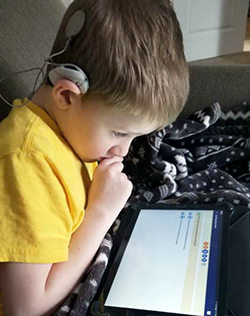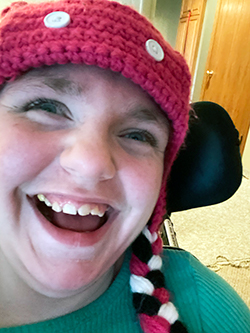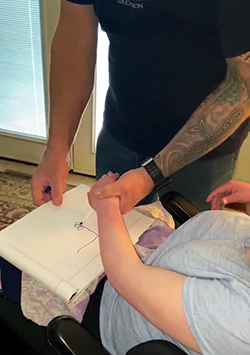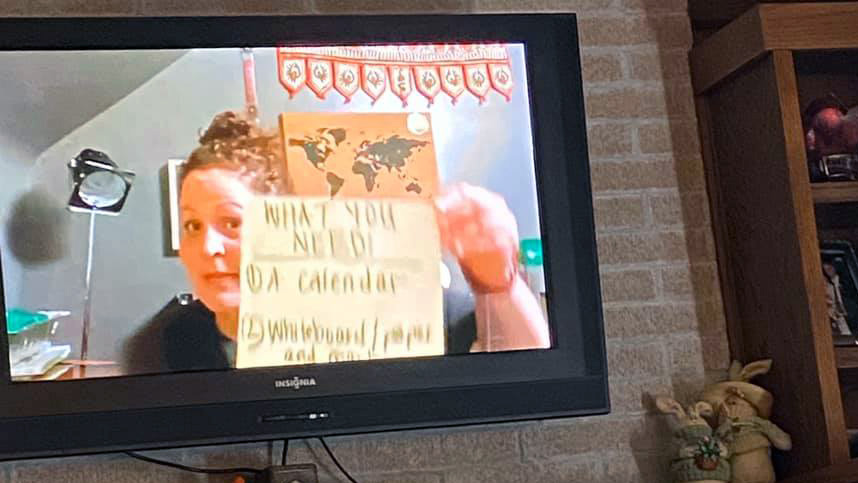Jessica Schmidt loves to see her teacher, Jessica Rodgers, on the TV screen. She recently participated in “Calendar Time,” recorded by the enthusiastic educator.

“She was laughing and laughing and laughing. She thought it was the best thing in the world,” said Jessica’s mom, Maureen Schmidt, of her daughter, 13, who has cerebral palsy.
Indeed, it’s hard not to giggle listening to Rodgers’ animated YouTube Calendar Time video, on which she leads activities based on the date for her students, ages 5 to 26. On March 25, one activity was to perform a movement 25 times: Strike a pose. Tap your knee. Stomp your feet. Clap your hands.
Rodgers’ students – including Jessica – attend Lincoln Developmental Center, a center-based special education program for students with severe multiple and cognitive impairments, and autism spectrum disorder. Rodgers is working hard to continue to meet their needs by supporting families and providing engaging activities for students during the state mandated school closure to slow the spread of COVID-19.

Kent ISD’s nine center-based programs are designed to provide a learning environment for students from age 3 to 26. Many need full-time support and care and receive speech, physical and occupational therapy through school. That typically requires physical interaction.
“This has been very eye-opening for us as to how much we actually do at school that we don’t always think about,” Rodgers said. “A lot of it is the physical therapy, the occupational therapy and equipment that parents don’t have at home that is the biggest struggle. To put everything on their plate: now you are also the teacher, but don’t forget you also have to do life on top of that … it’s been very hard for a lot of our families.”
Still, teachers are reaching out to be as present as possible in their lives – even when keeping a distance is required. Sometimes it’s through videos and online resources. Sometimes it’s through telephone calls, virtual meetings and handwritten letters.

Routine, Consistency
“Anything we send is more about what we can do to support the parents versus what the child can do independently,” Rodgers said, adding that teachers also set up a Facebook group to provide resources for parents. Recorded videos work best because, especially now, learning needs to happen with as little stress as possible.
“To do live stuff is very hard because one student might be sleeping at 9 a.m. and another might be wide awake and ready to learn. This allows the parents to be in control as to when is a good time for them to do school. We are just trying to provide resources to support the parents in what they are already doing.”
Maureen Schmidt and her husband, Dan Schmidt, say they greatly appreciate the effort. Jessica, who speaks just a few words, loves school and its social components.
“The nice thing with videos is we can throw those up on the TV and she can see them and have interaction, even though it’s a video,” Dan Schmidt said.

Keeping Connected with High-Need Students
Paul Dymowski, Kent ISD’s director of Special Education Center Programs, said staff members are working to develop a tele-therapy platform in Google Meet to conduct online therapy services, and are offering virtual instruction specifically designed for families over technology.
A big issue is access to the internet and technology. Staff is identifying those gaps as well, and sending Chromebooks to families.
Dymowski said many students are at critical stages of learning and development, and missing out on instruction can lead to regression.
“In my opinion – and research shows – face-to-face, direct instruction is most effective. But it’s not possible right now,” he said. “We have to think outside the box. Our staff would love to have students in the school right now. We will do everything we can to support them.”
Special education students are also required to have Individualized Education Program plans, which are documents created by a team of educators and parents that must be reviewed annually. Dymowski said educators are proceeding with reviews over the telephone and hosting virtual meetings with families, if they agree to the format. (If they do not, the IEP review will be completed after stay-at-home guidelines are lifted.)
Challenges and Activities
Debra Burkhardt teaches kindergarten through third graders in the North Oakview Elementary Oral Deaf program. She’s supplying her students with activities, keeping a sense of routine in their lives. Her version of Calendar Time works well for that, she said.
“They really assimilate to what that calendar says. It helps them to know what day it is and what’s going on. Every morning I send them a video with the calendar and a challenge.”

When students complete activities based on the challenge, they send her photos of what they have completed.
Amy Melendez is grateful for those resources for her son Lucas, 7, who is a kindergartner in the oral deaf program. Lucas, who had two cochlear implants placed at age 3 1/2 , has been working on reading and comprehension on Raz-Kids and doing math, reading and writing on Brainzyz, on which Burkhardt adds assignments to both. He’s also done fun activities suggested by Burkhardt such as building a fort to read in with a flashlight.
The time comes with challenges, Melendez said, including that Lucas gets speech therapy at school, which she can’t provide at the level staff does. “The knowledge the teachers have – how the brain grasps what they learn – it’s a very long process, and the brain goes through all this stuff from infancy.”
Jenna Darcy, a teacher at the Community Transition Campus, a program for young adults with special needs, is working to keep her adult students active and learning. She brought them challenge bags with meaningful activities including cooking supplies, materials to make a fleece blanket, grocery and bus route planning activities, word searches and puzzles.
She also does Facetime group chats and a Google Classroom for students who can access the internet.
Said Darcy, “I’ve been doing several different things to make sure everyone is able to stay connected and reinforce that we are all in this together.”










